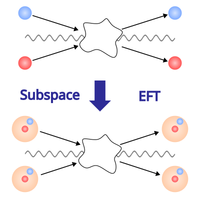Abstract
Atomic high-precision measurements have become a competitive and essential technique for tests of fundamental physics, the Standard Model, and our theory of gravity. It is therefore self-evident that such measurements call for a consistent relativistic description of atoms that eventually originates from quantum field theories like quantum electrodynamics. Most quantum metrological approaches even postulate effective field-theoretical treatments to describe a precision enhancement through techniques like squeezing. However, a consistent derivation of interacting atomic quantum gases from an elementary quantum field theory that includes both the internal structure as well as the center of mass of atoms, has not yet been addressed. We present such a subspace effective field theory for interacting, spin carrying, and possibly charged ensembles of atoms composed of nucleus and electron that form composite bosons called cobosons, where the interaction with light is included in a multipolar description. Relativistic corrections to the energy of a single coboson, light-matter interaction, and the scattering potential between cobosons arise in a consistent and natural manner. In particular, we obtain a relativistic coupling between the coboson’s center-of-mass motion and internal structure encoded by the mass defect. We use these results to derive modified bound-state energies, including the motion of ions, modified scattering potentials, a relativistic extension of the Gross-Pitaevskii equation, and the mass defect applicable to atomic clocks or quantum clock interferometry.
1 More- Received 4 August 2023
- Revised 8 March 2024
- Accepted 14 March 2024
DOI:https://doi.org/10.1103/PRXQuantum.5.020322
Published by the American Physical Society under the terms of the Creative Commons Attribution 4.0 International license. Further distribution of this work must maintain attribution to the author(s) and the published article's title, journal citation, and DOI.
Published by the American Physical Society
Physics Subject Headings (PhySH)
Popular Summary
Atomic sensors are powerful devices for testing general relativity and the standard model. To fully harness the advantage of their quantum nature, including their motion, internal structure, and many-body behavior, an effective field theory is the method of choice. We derive such a description from the underlying fundamental theory. Our results open the door for clocks and matter-wave interferometers detecting relativistic effects with a precision higher than allowed by classical physics. At the same time, we find the mass defect originating from the energy-mass equivalence, where the internal energies of the atom lead to different masses that influence the atom’s motion. This effect constitutes the basis for quantum clock interferometry.
We follow a top-down approach, starting with quantum electrodynamics to describe bound systems at low energies, leading eventually to ultracold atoms. Our theory treats interacting ensembles of spin carrying, possibly charged composite bosons, such as atoms or ions. Based on the motion of the constituents of each atom and its relativistic corrections, we derive the atomic energy structure, its effect on the motion of an atom, and scattering potentials between atoms, as well as the interaction with light. With that, we find corrections to the Gross-Pitaevskii equation, including the mass defect, a nonlinear Schrödinger-type equation that describes degenerate quantum gases like Bose-Einstein condensates.
Our method can be generalized to effective field theories on other length and energy scales, such as multispecies quantum gases or cold molecules. The results can directly be applied to modeling atomic sensors for dark matter, the theory of relativity, or gravitational waves.



